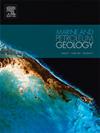Tight origin and hydrocarbon potential of shell interlayers in shale: A case of Lower Jurassic Dongyuemiao member, Sichuan Basin, China
IF 3.7
2区 地球科学
Q1 GEOSCIENCES, MULTIDISCIPLINARY
引用次数: 0
Abstract
Tight shell interlayers are widely distributed in global marine and lacustrine organic-rich shale successions, serving as key targets for reservoir prediction. However, the limited understanding of these interlayers presents challenges in characterising reservoirs and optimising hydrocarbon recovery in shell-rich shale formations. This study investigates the Lower Jurassic Dongyuemiao Member in the Sichuan Basin, Southwest China, using petrological, geochemical, and pore structure characterization techniques to differentiate shale from shell interlayers, and investigate the mechanisms underlying the tight properties of shell-rich interlayers. Results suggest that two shale lithofacies (e.g., laminated argillaceous shale and massive mixed mudstone) and two shell interlayer lithofacies (e.g., bedded-to-laminated shelly-bearing argillaceous mudstone and massive shell limestone) were identified. Porosity, permeability, and total organic carbon content of shale lithofacies are significantly higher than those of interlayer lithofacies. Special attention was therefore given to the analysis of sedimentary processes and diagenesis occurring in the two interlayer lithofacies. Shell interlayers were deposited by sediment gravity flows triggered by storm events. The two shell interlayers were considered the products of low-density turbidity currents and cohesive debris flows. Among the two shell interlayers, massive shell limestones exhibited the worst reservoir quality due to their fine mud-grade matrix compositions and non-lamellar textures. Differential compaction had a significant impact on the heterogeneous distribution of cements in interlayer lithofacies. Additionally, massive shell limestones experienced three distinct stages of cementation, including eogenetic calcareous cement and pyrite, and mesodiagenetic microquartz, which filled intergranular pores in the massive shell limestones and reduced reservoir quality. By contrast, the bedded-to-laminated shelly-bearing argillaceous mudstone also underwent three stages of cementation, comprising eogenetic pyrite, mesodiagenetic microquartz and ferroan calcite cement. However, close contact with black shales facilitated the development of dissolved pores within the lithofacies. Finally, based on sedimentary and diagenetic processes, tight models were established for different shell interlayers, making them applicable to other shell-rich shale successions for shale gas and oil exploration and production worldwide.
求助全文
约1分钟内获得全文
求助全文
来源期刊

Marine and Petroleum Geology
地学-地球科学综合
CiteScore
8.80
自引率
14.30%
发文量
475
审稿时长
63 days
期刊介绍:
Marine and Petroleum Geology is the pre-eminent international forum for the exchange of multidisciplinary concepts, interpretations and techniques for all concerned with marine and petroleum geology in industry, government and academia. Rapid bimonthly publication allows early communications of papers or short communications to the geoscience community.
Marine and Petroleum Geology is essential reading for geologists, geophysicists and explorationists in industry, government and academia working in the following areas: marine geology; basin analysis and evaluation; organic geochemistry; reserve/resource estimation; seismic stratigraphy; thermal models of basic evolution; sedimentary geology; continental margins; geophysical interpretation; structural geology/tectonics; formation evaluation techniques; well logging.
 求助内容:
求助内容: 应助结果提醒方式:
应助结果提醒方式:


